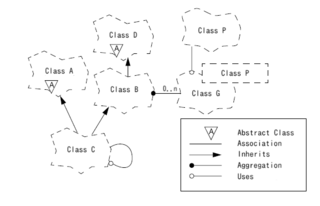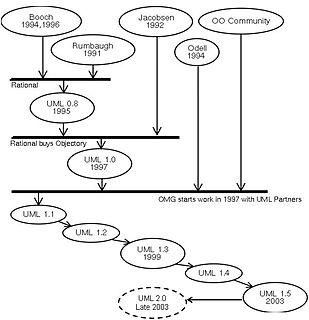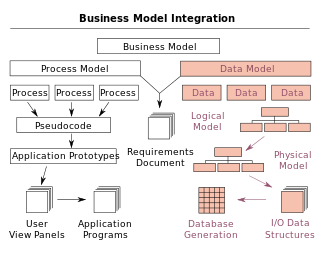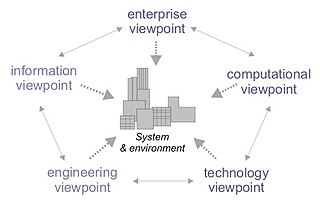
The Booch method is a method for object-oriented software development. It is composed of an object modeling language, an iterative object-oriented development process, and a set of recommended practices.

The Object Management Group (OMG) is a computer industry standards consortium. OMG Task Forces develop enterprise integration standards for a range of technologies.

An object-modeling language is a standardized set of symbols used to model a software system using an object-oriented framework. The symbols can be either informal or formal ranging from predefined graphical templates to formal object models defined by grammars and specifications.

The Unified Modeling Language (UML) is a general-purpose, developmental modeling language in the field of software engineering that is intended to provide a standard way to visualize the design of a system.

A data model is an abstract model that organizes elements of data and standardizes how they relate to one another and to the properties of real-world entities. For instance, a data model may specify that the data element representing a car be composed of a number of other elements which, in turn, represent the color and size of the car and define its owner.
Software design is the process by which an agent creates a specification of a software artifact intended to accomplish goals, using a set of primitive components and subject to constraints. Software design may refer to either "all the activity involved in conceptualizing, framing, implementing, commissioning, and ultimately modifying complex systems" or "the activity following requirements specification and before programming, as ... [in] a stylized software engineering process."
Software development is the process of conceiving, specifying, designing, programming, documenting, testing, and bug fixing involved in creating and maintaining applications, frameworks, or other software components. Software development involves writing and maintaining the source code, but in a broader sense, it includes all processes from the conception of the desired software through to the final manifestation of the software, typically in a planned and structured process. Software development also includes research, new development, prototyping, modification, reuse, re-engineering, maintenance, or any other activities that result in software products.
A modeling language is any artificial language that can be used to express information or knowledge or systems in a structure that is defined by a consistent set of rules. The rules are used for interpretation of the meaning of components in the structure.
Model Driven Architecture (MDA) is a software design approach for the development of software systems. It provides a set of guidelines for the structuring of specifications, which are expressed as models. Model Driven Architecture is a kind of domain engineering, and supports model-driven engineering of software systems. It was launched by the Object Management Group (OMG) in 2001.
The Object Constraint Language (OCL) is a declarative language describing rules applying to Unified Modeling Language (UML) models developed at IBM and is now part of the UML standard. Initially, OCL was merely a formal specification language extension for UML. OCL may now be used with any Meta-Object Facility (MOF) Object Management Group (OMG) meta-model, including UML. The Object Constraint Language is a precise text language that provides constraint and object query expressions on any MOF model or meta-model that cannot otherwise be expressed by diagrammatic notation. OCL is a key component of the new OMG standard recommendation for transforming models, the Queries/Views/Transformations (QVT) specification.

IDEF, initially an abbreviation of ICAM Definition and renamed in 1999 as Integration Definition, is a family of modeling languages in the field of systems and software engineering. They cover a wide range of uses from functional modeling to data, simulation, object-oriented analysis and design, and knowledge acquisition. These definition languages were developed under funding from U.S. Air Force and, although still most commonly used by them and other military and United States Department of Defense (DoD) agencies, are in the public domain.

Computer-aided software engineering (CASE) is the domain of software tools used to design and implement applications. CASE tools are similar to and were partly inspired by Computer-Aided Design (CAD) tools used for designing hardware products. CASE tools were used for developing high-quality, defect-free, and maintainable software. CASE software is often associated with methods for the development of information systems together with automated tools that can be used in the software development process.
A BRMS or business rule management system is a software system used to define, deploy, execute, monitor and maintain the variety and complexity of decision logic that is used by operational systems within an organization or enterprise. This logic, also referred to as business rules, includes policies, requirements, and conditional statements that are used to determine the tactical actions that take place in applications and systems.
The Shlaer–Mellor method, also known as Object-Oriented Systems Analysis (OOSA) or Object-Oriented Analysis (OOA) is an object-oriented software development methodology introduced by Sally Shlaer and Stephen Mellor in 1988. The method makes the documented analysis so precise that it is possible to implement the analysis model directly by translation to the target architecture, rather than by elaborating model changes through a series of more platform-specific models. In the new millennium the Shlaer–Mellor method has migrated to the UML notation, becoming Executable UML.
Model-driven engineering (MDE) is a software development methodology that focuses on creating and exploiting domain models, which are conceptual models of all the topics related to a specific problem. Hence, it highlights and aims at abstract representations of the knowledge and activities that govern a particular application domain, rather than the computing concepts.

Reference Model of Open Distributed Processing (RM-ODP) is a reference model in computer science, which provides a co-ordinating framework for the standardization of open distributed processing (ODP). It supports distribution, interworking, platform and technology independence, and portability, together with an enterprise architecture framework for the specification of ODP systems.
Service-oriented modeling is the discipline of modeling business and software systems, for the purpose of designing and specifying service-oriented business systems within a variety of architectural styles and paradigms, such as application architecture, service-oriented architecture, microservices, and cloud computing.
Catalysis is a software design method for the specification and design of component-based computer systems originally developed by Desmond D’Souza and Alan Cameron Wills in their 1999 book.

In systems engineering, software engineering, and computer science, a function model or functional model is a structured representation of the functions within the modeled system or subject area.
A metaCASE tool is a type of application software that provides the possibility to create one or more modeling methods, languages or notations for use within the process of software development. Often the result is a modeling tool for that language. MetaCASE tools are thus a kind of language workbench, generally considered as being focused on graphical modeling languages.








